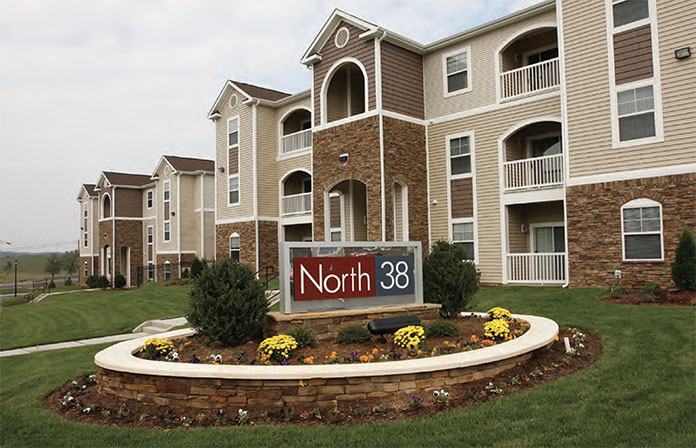
Apartment REITs, despite their ability to finance development projects on their own balance sheet, were not the first out of the gate.
Instead, it was privately held real estate company Wood Partners, which has a development pipeline that rivals any firm in the industry today—public or private. The 12-year old Atlanta-based company was a national leader in market-rate apartment starts in 2010 with more than 2,000 units started, representing more than $400 million worth of development.
Of the REITs, only AvalonBay, the nation’s largest and most active publically traded apartment developer, gave Wood Partners’ 2010 production starts a run for the money, with 12 projects underway valued at $670 million as of the end of the third quarter and several more breaking ground in Q4. At least four of those projects are second phases of communities already in operation and a few are highrises that were started in previous years before the downturn.
Wood Partners jump-started 2011 with the announcement of a new joint venture with a co-investment fund sponsored by global real estate investment management firm CB Richard Ellis Investor’s U.S. Strategic Opportunity Fund 5 (SP5) and a top-3 state pension fund. The programmatic joint venture will be used to develop and construct $400 million of Class-A apartment communities across the country.
In January, Wood Partners broke ground on the 290-unit The Heights at Groveton, a luxury apartment community on three acres at the site of the former Beacon Field Airport along U.S. Route 1 in Alexandria, Va. Completion is scheduled for the end of 2012. The project is a partnership with Redbrick Development Group.
Working through the Great Recession
Despite Wood Partners’ current success, there is no denying that the recent recession inflicted serious pain and served up some hard lessons that appropriately influence the new leadership team as they carefully enter a novel phase of company growth.
Being almost entirely focused on development left Wood Partners especially vulnerable to the downturn. Even so, the company fared better than a number of its counterparts, those private development firms considered merchant builders, many of which no longer exist in their original structure. JPI was first to shutter its doors in January 2009, followed by Fairfield Residential declaring bankruptcy in December 2009, and, most recently, Trammell Crow Residential, which in August spun out its people into a new entity, Mill Creek Residential Trust, that is currently seeking organizational financing.
How did Wood Partners weather the storm? A timely entity-level transaction with CBREI’s Special Opportunity Fund 5 (SP5) in March 2008, just before the recession began in earnest, gave CBREI a majority stake in Wood Partners, tripling the developer’s liquidity. As Wood Partners CEO Ryan Dearborn explained, “The transaction with CBREI’s SP5 aligned us with a first-class strategic and capital partner and allowed us to significantly bolster our company’s liquidity just as we were entering the worst of the recession.”
Another key factor was the state of Wood Partners’ balance sheet in 2008. The company entered the recession with lower leverage than the industry average and with limited land and condominium exposure.
“Our limited land and condo exposure provided us ample flexibility when it came time to restructure the $1 billion-plus of maturities we were facing in 2008 and 2009. Restructuring cash-flow generating Class-A apartments located in primary markets is less complicated than land and condo restructurings,” said Joe Keough, Wood Partners CFO/COO.
Wood Partners also was more conservative than many of its peers with regards to leverage levels. “At the time we had about 70 percent leverage, debt to total cost, compared to an industry average well north of 80 percent. This relatively lower leverage made our restructuring efforts more feasible and less costly from a rebalancing perspective,” said Keough.
Dearborn agreed: “We started early and pulled out early and were left with only a couple of condo deals that we had to work through when the market turned. As we sit here today, we are happy to say that we have no condo exposure remaining on our balance sheet.”
As the recession deepened, Wood Partners shifted into survival mode and aggressively pruned its workforce and cut overhead by 40 percent in 2009, moving some of its remaining development personnel over to asset management and a newly formed restructuring group.
A best-in-class core development team remained in place, focused on tying up land sites via no-cash-down contract options. This critical move allowed Wood Partners to build an attractive pipeline without sacrificing its liquidity.
Toward the end of 2009 and into 2010, Wood Partners and other multifamily players were helped by a significant increase in the value of existing multifamily assets. Driven by an improving global macroeconomic picture, low interest rates, availability of Freddie and Fannie debt and a return of investors’ risk appetite, multifamily asset values improved drastically through 2010. Noticing this value appreciation, Wood Partners jumped on the opportunity to sell assets, generating sorely needed cash for the company, as well as significantly de-levering its balance sheet.
“In 2010 we sold 4,000 units, which retired $500 million worth of debt and allowed us to raise nearly $20 million of cash for the company,” noted Keough.
In addition to selling assets, Wood Partners continues to take advantage of the availability of attractively priced Fannie and Freddie permanent debt.
“As a result of our disposition and refinancing programs, we have decreased our contingent liability exposure by 50 percent and made ourselves considerably more bankable as we approach our banking partners for new loans,” added Keough.
Entering a new growth phase
As Wood Partners entered the second quarter of 2010, a strange thing started to happen—development no longer was heard as a disparaging word. The company’s blue-chip institutional equity partners began returning calls and started talking about investing in new developments.
In Dearborn’s opinion, this was partially driven by the frothiness of the acquisition market. “We were an active seller throughout 2010 as we saw the tremendous implied rent growth and cap rate compression in the prices we were being offered for our existing assets. Our savvy institutional equity partners saw the difference in un-trended yields between a new development and an acquisition and turned quickly to development. These early movers will be rewarded handsomely, as they always are.” He said
As institutional equity became more interested in development, Wood Partners had the benefit of CBREI’s experienced guidance and capability in raising such institutional equity. In the second quarter of 2010, Vance Maddocks, the president of CBREI’s Special Opportunity fund series, began approaching various state pension funds to discuss a programmatic development relationship with CBREI and Wood Partners. In the fourth quarter, CBREI and Wood Partners finalized the details of a $400 million programmatic development fund with CBREI’s SP5 and a top-three state pension fund—the first of its kind since the development cycle turned.
“The partnership with CBREI continues to produce dividends for Wood Partners. Our programmatic equity fund has allowed us to get a core set of development starts out of the ground in 2010, which are well diversified across the country,” said Dearborn.
The first $300 million of the $400 million has been allocated to deals that started in 2010 and the remaining $100 million is being allocated during the first quarter of 2011. The starts are nationwide with a focus on coastal markets, including projects in Boston, Atlanta, Dallas, Denver, San Diego and Washington, D.C.
Wood Partners is already organizing to raise a second fund and, according to company execs, early interest is extremely high.
“Our 2010 performance, the attractiveness of our pipeline together with our industry-leading development team has resulted in a high level of interest from a number of blue-chip institutional equity partners. We are excited about raising an additional fund and building off of our success in 2010,” noted Keough.
Despite the productive conversations with equity investors, access to construction debt to fulfill Wood Partners’ burgeoning development pipeline remains the biggest hurdle going forward.
“Securing construction debt continues to be the critical path for any development start. Having said that, we are finding a way to get deals done by targeting smaller regional and community banks and by putting more equity in deals,” said Keough.
Wood Partners’ 2010 starts had, on average, 55 percent debt to total cost, compared to the prior cycle peak of 80 percent-plus on average across the industry. According to Deaarborn, this lower leverage is feasible given the attractiveness of these early-cycle deals and their considerable upside as they are delivered into supply windows with limited competition.
“We are forecasting above-average rent growth in these markets as the economy improves through 2011 and 2012,” he said. “We believe our 2010 and 2011 vintage development deals will be the most profitable of this new development cycle.”
Wood Partners also expanded its breadth operationally and geographically with the opening of a Seattle office to expand its reach to the Pacific Northwest. “With 15 development offices across the country, we truly are a national platform,” said Dearborn.
Stronger, wiser and more diversified
Determined to diversify its revenue stream so that it was less dependent on development-a key lesson of the Great Recession for the company—Wood Partners diversified its business lines by forming an acquisitions group and an in-house property management company in 2010. Mike Hefley, former COO of the then publicly-traded REIT Gables Residential, was hired to run Wood Partners’ property management and asset management groups. Acquisition veterans Curtis Walker and Don Foster were hired last June and report to Jay Jacobson, who is leading the acquisition effort for Wood Partners.
“We are extremely happy with our acquisition and property management strategies. Hefley and Jacobson are doing a great job and have gotten us off to a fast start in both businesses,” said Dearborn.
Wood Partners surprised the industry with its expeditious start in the acquisition space, closing on more than 3,200 units and $400 million worth of assets last year, a volume that ranks Wood Partners in the topten nationwide in acquisitions.
The company’s acquisitions team closed on its first transaction in November, when Wood Partners and its equity partner in the deal, AREA Property Partners, bought the six-month-old, 27-story, 324-unit Terrazas River Park Village in Miami, Fla., for $44 million, or $135,800 per unit, well below replacement cost for a newly completed high-rise originally built as condos.
The luxury two-tower asset with one-, two- and three-bedroom units, some offering views of the Miami River, had gone back to the lender. Builder Windmoor Project had received an $84.5 million mortgage from iStar Financial to build the property in 2006 and iStar took back the asset in a deed in lieu of foreclosure.
In December, Wood Partners acquiredthe 168-unit Magnolia Village in Jacksonville, Fla., on a short-sale basis at a significant discount to replacement costs. Built in 2008, Magnolia Village encompasses six buildings with 168 units on an 8.44-acre site located in Jacksonville’s desirable Southside neighborhood.
Wood Partners topped off the year with the acquisition of a nine-property Texas portfolio consisting of 2,589 units located in Dallas/Fort Worth, Houston and San Antonio in December of 2010.
“We acquired class-A assets from Miami to Jacksonville and across Texas. All of the transactions were off-market or lightly-marketed deals, which we believe will generate above-average returns to our investors,” said Keough. “Our on-the-ground development presence in these markets allowed us to source these deals and underwrite them more effectively than the competition. As a result, we were able to get them at belowreplacement cost and create significant return upside for our equity partners. We are now focused on exceeding this production level in 2011.”

A brighter future
Emboldened by some tough lessons learned through the recession, lucky to be in one of the most attractive real estate sectors and blessed with a strong and hungry leadership team, Wood Partners is entering 2011 with aggressive goals.
The company aims to start 4,000 unit start 4,000 units this year, representing $800 million of new development, $50 million more than AvalonBay’s preliminary outlook for development in 2011, shared with attendees of the REIT’s investor day presentation in November.
Wood Partners also plans to exceed its 2010 acquisition performance and expects to have more than 20 properties managed internally by its new property management company.
“We also plan to raise multiple programmatic development funds in 2011, as well as our first acquisition programmatic fund,” says Dearborn.
Amidst an ever-dynamic industry and economy, Wood Partners appears to be well positioned to write a new and profitable chapter in its impressive history.
“The past few years have been seminal ones for our industry. Many of our competitors have gone bankrupt, significantly restructured, or are still struggling to turn the corner,” We have come out of this more quickly than most. With our established and productive acquisition team, the best and largest development pipeline in the country and a healthy balance sheet, Wood Partners enters 2011 with extremely strong momentum,” said Keough.
Author Wendy Broffman















